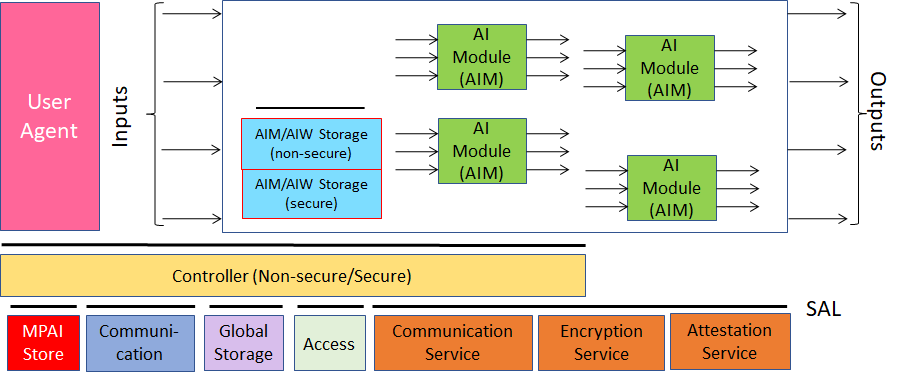(Informative)
Technical Specification: Object and Scene Description (MPAI-OSD) – in the following also called MPAI-OSD – has been developed by MPAI – Moving Picture, Audio, and Data Coding by Artificial Intelligence, the international, unaffiliated, non-profit organisation developing standards for Artificial Intelligence (AI)-based data coding with clear Intellectual Property Rights licensing frameworks in compliance with the rigorous MPAI Process [9,10] in pursuit of the following policies:
- Be friendly to the AI context but, to the extent possible, agnostic to the technology – AI or Data Processing – used in an implementation.
- Be attractive to different industries, end users, and regulators.
- Address three levels of standardisation all exposing standard interfaces with an aggregation level decided by the implementer:
- data types.
- Components called AI Modules (AIM).
- Configurations of AIMs called AI Workflows (AIW).
- Specify the data exchanged by AIMs with as clear a semantic as possible.
As manager of the MPAI Ecosystem specified by Governance of MPAI Ecosystem (MPAI-GME) [1] and ensures that a user can:
- Operate a reference implementation of the Technical Specification, by providing a Reference Software Specification with annexed software.
- Test the conformance of an implementation with the Technical Specification, by providing the Conformance Testing Specification.
- Assess the performance of an implementation of a Technical Specification, by providing the Performance Assessment Specification.
- Get conforming implementations possibly with a performance assessment report from a trusted source through the MPAI Store.
Technical Specification: AI Framework (MPAI-AIF) [2] specifies a standard AI Framework (AIF) that enables dynamic configuration, initialisation, and control of AIWs depicted in Figure 1.

Figure 1 – The AI Framework (MPAI-AIF) V2 Reference Model
MPAI-AIF enabling the secure execution of AI Workflows (AIW) that can be constituted by AI Modules (AIM). Thus, users can have machines whose internal operation they understand to some degree, rather than machines that are just “black boxes” resulting from unknown training with unknown data and component developers can provide components with standard interfaces that can have improved performance compared to other implementations.
An AIW and its AIMs may have 3 interoperability levels:
Level 1 – Implementer-specific and satisfying the MPAI-AIF Standard.
Level 2 – Specified by an MPAI Application Standard.
Level 3 – Specified by an MPAI Application Standard and certified by a Performance Assessor.
Users are free to adopt any of the three levels.
AIM can execute data processing or Artificial Intelligence algorithms and can be implemented in hardware, software, or hybrid hardware/software. AI Module can be Composite if they include connected AI Modules.
The MPAI-MMC V2 Technical Specification can be implemented in one of the following modalities:
- As a specific AIW implementing a Use Case, as specified in this document.
- As a specific AIM, as specified in this document.
- As a specific data type, as specified in this document.
However, MPAI does not mandate the choice of modality, which remains the sole decision of the implementer.
In many MPAI Technical Specifications there are data types that refer to Objects and Scenes that can be uni- and multimodal and possibly refer to locations that may be in a physical or virtual space.
MPAI values the consistent use of data types across its Technical Specifications. Therefore, MPAI-OSD has been developed to be the reference point for the consistent use of data types across MPAI standards. When consistency is not possible because different usages are consolidated, such usages are clearly identified, and individual specific usages recorded.
Currently, there are no MPAI-OSD specific Use Cases. Therefore, only the Scope, Reference Models, and I/O Data of relevant Use Cases from other Technical Specifications are reported here. The full Use Case specification can be found in the Technical Specifications owning the Use Cases. All Use Cases are assumed to be implemented according to the MPAI-AIF.
MPAI-OSD will be accompanied by the Reference Software, Conformance Testing, and Performance Assessment Specifications. Conformance Testing specifies methods enabling users to ascertain whether a data type generated by an AIM, an AIM, or an AIW conform with this Technical Specification.

